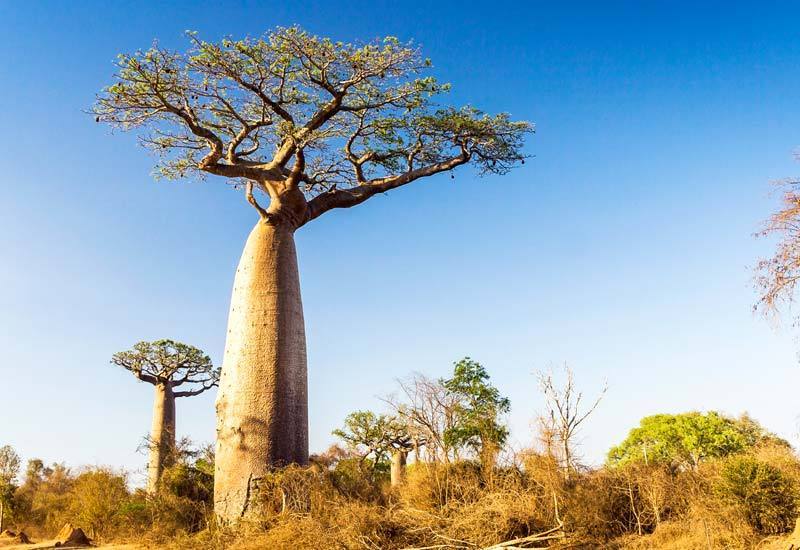Known as the “Tree of Life,” the Baobab (Adansonia digitata) is one of the most iconic and fascinating trees on Earth.
Towering over the African savanna, this ancient tree is famous for its massive trunk, extraordinary lifespan, and its vital role in supporting ecosystems and communities.
Beyond its striking appearance, the Baobab provides food, water, medicine, and shelter making it one of nature’s true survival miracles.
Origin and Distribution
The Baobab tree is native to Africa, particularly across sub-Saharan regions, Madagascar, and parts of Australia.
The species Adansonia digitata is the most widespread and well-known, commonly found in countries like Senegal, Tanzania, Botswana, and South Africa.
Baobabs thrive in dry, arid climates, adapting perfectly to areas with long droughts and limited rainfall.

Unique Appearance and Structure
The Baobab is instantly recognizable for its enormous, bottle-shaped trunk, which can reach up to 25 meters in height and 14 meters in diameter.
Its thick, fibrous bark can store thousands of liters of water a crucial adaptation that allows it to survive the harsh African dry season.
In the dry months, the Baobab often looks as if it has been planted upside down, with its bare branches resembling roots stretching toward the sky.
During the rainy season, the tree sprouts lush green leaves and large, white, waxy flowers that open at night, pollinated mainly by bats.
Lifespan and Growth
Baobab trees are among the oldest living organisms on Earth.
Some are estimated to be over 2,000 years old, with carbon dating confirming their ancient origins.
Unlike most trees, Baobabs do not form annual rings; instead, their age is determined by radiocarbon analysis and trunk measurements.
Ecological Importance
The Baobab plays a crucial role in its environment.
- Water storage: Its spongy trunk can hold up to 120,000 liters of water, acting as a natural reservoir.
- Wildlife habitat: Birds, bats, and insects often live in its hollows.
- Pollination: The tree’s night-blooming flowers support nocturnal pollinators like bats and moths.
- Soil enrichment: Fallen leaves decompose quickly, returning nutrients to the soil.
The Baobab is a keystone species without it, many local ecosystems would collapse.
Nutritional and Medicinal Uses
The Baobab is not just vital for nature; it’s a superfood powerhouse for humans too.
Its fruit, known as “monkey bread” or “cream of tartar fruit,” contains a powdery pulp rich in:
- Vitamin C (up to 10 times more than oranges)
- Antioxidants and fiber
- Calcium, potassium, and magnesium
Locals use Baobab fruit to boost immunity, aid digestion, and fight dehydration.
Its leaves are eaten as vegetables, while the seeds can be pressed into nutrient-rich Baobab oil, used in cosmetics and skin care.
Traditional medicine also employs the bark and roots for treating fever, diarrhea, and inflammation.
Cultural and Spiritual Significance
Across Africa, the Baobab holds deep spiritual and cultural symbolism.
Many tribes view it as sacred, believing that spirits dwell within its trunk.
It often serves as a meeting place, market center, or village landmark.
Because of its resilience and longevity, the Baobab represents wisdom, strength, and community.
Conservation and Threats
Despite its endurance, Baobabs face growing threats from climate change, deforestation, and human expansion.
In recent years, scientists have reported the sudden death of some ancient Baobabs, likely due to prolonged drought and temperature shifts.
Conservation efforts now focus on protecting habitats, planting new trees, and raising awareness of their ecological value.
Key Facts about the Baobab Tree
| Feature | Description |
|---|---|
| Scientific Name | Adansonia digitata |
| Common Name | Baobab / Tree of Life |
| Family | Malvaceae |
| Native Habitat | Sub-Saharan Africa |
| Height | Up to 25 meters |
| Trunk Diameter | Up to 14 meters |
| Lifespan | 1,000–2,000+ years |
| Flowers | Large, white, night-blooming, pollinated by bats |
| Fruit | Baobab fruit (rich in Vitamin C and antioxidants) |
| Conservation Status | Stable but threatened locally by climate change |





